

Hierarchy and Network: Two Structures, One Organization - John P. Kotter. By John P.

Kotter | 1:01 PM May 23, 2011 Almost all companies organize people in a hierarchy, and then run well known managerial processes (planning, budgeting, staffing, measuring, etc) with it. We have all seen so many hierarchical org charts — sprawling boxes of letters and arrows arranged in inverted pyramids — and have been through so many budget, planning, and problem solving meetings, that we take all of this as a given, as if it had existed forever. In fact, it hasn’t. Toyota Motor Manufacturing (UK) Ltd. The Failure Of The FBI’s Virtual Case File Project. Between 2001 and 2005, the FBI’s Virtual Case File project failed.
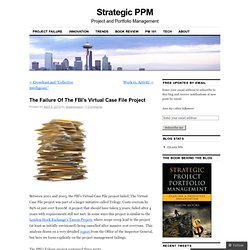
The Virtual Case File project was part of a larger initiative called Trilogy. Costs overran by 89% or just over $200M. A project that should have taken 3 years, failed after 4 years with requirements still not met. In some ways this project is similar to the London Stock Exchange’s Taurus Project, where scope creep lead to the project (at least as initially envisioned) being cancelled after massive cost overruns.
This analysis draws on a very detailed report from the Office of the Inspector General, but here we focus explicitly on the project management failings. Problems with Hierarchical Structures. Mintzberg’s typology of organizations is a theory that has caught my attention.
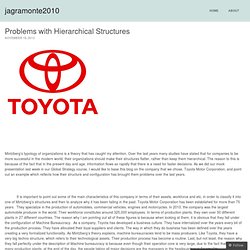
Over the last years many studies have stated that for companies to be more successful in the modern world, their organizations should make their structures flatter, rather than keep them hierarchical. Principles of Management 1.1. Figure 7.3 Source: Photograph courtesy of Toyota Motor Sales, USA, Inc.
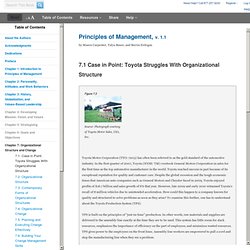
Toyota Motor Corporation (TYO: 7203) has often been referred to as the gold standard of the automotive industry. In the first quarter of 2007, Toyota (NYSE: TM) overtook General Motors Corporation in sales for the first time as the top automotive manufacturer in the world. Toyota reached success in part because of its exceptional reputation for quality and customer care. Despite the global recession and the tough economic times that American auto companies such as General Motors and Chrysler faced in 2009, Toyota enjoyed profits of $16.7 billion and sales growth of 6% that year. Virtual Case File. Virtual Case File (or VCF) was a software application developed by the United States Federal Bureau of Investigation (FBI) between 2000 and 2005.

The project was officially abandoned in April 2005, while still in development stage and cost the federal government nearly $170 million. In 2006, the Washington Post wrote "In a 318-page report, completed in January 2005 and obtained by The Post under the Freedom of Information Act, [the Aerospace Corporation] said the SAIC software was incomplete, inadequate and so poorly designed that it would be essentially unusable under real-world conditions. Even in rudimentary tests, the system did not comply with basic requirements, the report said. It did not include network-management or archiving systems—a failing that would put crucial law enforcement and national security data at risk"[1] Origins[edit] Launch[edit]
About Toyota Culture. We firmly believe that a group of motivated people can achieve far more than the sum of their individual efforts.
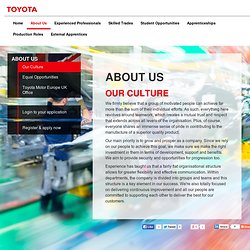
As such, everything here revolves around teamwork, which creates a mutual trust and respect that extends across all levels of the organisation. Plus, of course, everyone shares an immense sense of pride in contributing to the manufacture of a superior quality product. Our main priority is to grow and prosper as a company. Since we rely on our people to achieve this goal, we make sure we make the right investment in them in terms of development, support and benefits. We aim to provide security and opportunities for progression too.
Experience has taught us that a fairly flat organisational structure allows for greater flexibility and effective communication. TOYOTA MOTOR CORPORATION GLOBAL WEBSITE. Toyota has actively propelled growth and innovation in its information systems by incorporating new information processing technologies while responding to various changes in the external environment, including rapid globalization of development, manufacturing, and sales operations; advancements in car electronics technologies; compliance with global environmental standards; and changes in the Japanese and global economy.
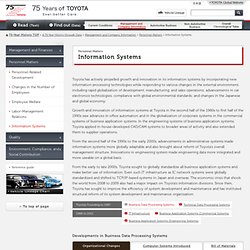
Toyota’s IT Transformation. This article was written with Karen Nocket.
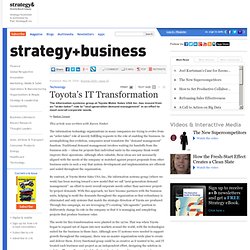
The information technology organizations in many companies are trying to evolve from an “order-taker” role of merely fulfilling requests to the role of enabling the business. In accomplishing this evolution, companies must transform the “demand management” function. Traditional demand management involves waiting for handoffs from the business side — ideas for projects that individual units in the company think would improve their operations. Although often valuable, these ideas are not necessarily aligned with the needs of the company or matched against project proposals from other business units in such a way that system development and implementation are efficient and scaled throughout the organization. The seeds for this transformation were planted in the 1970s. With many projects under development and limited resources, we began to rely on contracted outsourced help. It became clear that we needed to create a new operating model. FBI (1)